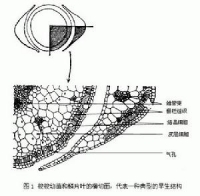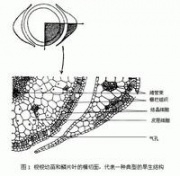|
|
 旱生植物 简介 旱生植物 简介
旱生植物通常是指定水植物中的适旱类型,区别于耐旱型植物。即通过形态或生理上的适应,可以在干旱地区保持体内水分以维持生存的植物。广义的旱生植物也包括耐旱型植物。
近年根据沙生植物(生长在沙漠地区的植物)的研究表明,沙生植物要能在沙漠地区生存,除了能够耐受干旱以外,还必须能够耐受营养不良(“饥饿”)。这样,一方面要发展出某种机制以减少水分的丧失,同时又需要维持高效能的光合作用。沙生植物要维持这种生理上的平衡,可以称为“水份-光合作用的综合关系”。而它们的形态结构也就随着这些生理上的要求,发生某些相适应的变化。
一般在严重缺水和强烈光照下生长的植物,植株往往变得粗壮矮化。地上气生部分发育出种种防止过分失水的结构,而地下根系则深入土层,或者形成了储水的地下器官。另一方面,茎干上的叶子变小或丧失以后,幼枝或幼茎就替代了叶子的作用,在它们的皮层细胞或其他组织中可具有丰富的叶绿体,进行光合作用。
另外,沙漠地区的很多木本植物,由于长期适应干旱的结果,多成灌木丛,这在沙漠上生长有很多优越性。
至于许多生长在盐碱地的所谓盐生植物,或旱-盐生植物,由于生理上缺水,也同样显出一般旱生的结构。 |
适旱变形 Appropriate drought deformation |
 旱生植物 适旱变形 旱生植物 适旱变形
一、根的变化
一般对于植物地下部分的根系生长的了解,远不及地上的茎、叶。这是由于根系扎入土中,观察有很多困难。而且,旱生植物很多是深根性的根系,研究就更不容易。现知旱生植物的根部。大致可有下列一些变化。
旱生植物有较高的根/ 茎比率。有的主根的生长可以很深,例如一种滨藜(atriplex sp.)地上的茎干虽然只有1—2米高,但是主根却可深达4—5米。据说牧豆树(prosopis)和骆驼刺(alhagi)的主根竟可深达20米!
根系有不同程度的肉质化,这种肉质化主要是一些薄壁细胞的增加,但并不是单纯皮层部分的增加。根的皮层层数反而减少(表1)。有人认为这样可以使中柱与土壤更为接近。有些旱生植物中还可以发现皮层中分布有石细胞,但是它们的生理功能还不清楚。
内皮层细胞壁加厚,凯氏带变宽。凯氏带的变宽,似与旱生的性状有一定的关系。极端的情况,凯氏带可以整个包围了内皮层细胞的径向壁和横向壁,例如一种白刺(nitraria retusa)。
沙生植物往往形成分离的维管柱。这是由于木栓层的形成,或维管束之间皮层薄壁细胞的坏死,隔开了维管组织的结果。相对的,木质部比较发达,这可能更有效地输送水份。
二、茎的适应
茎是地上的重要部分,经受干旱的影响,远比根部显著,也比较容易观察,它们在形态解剖上的变化是:
沙漠里生长的多年生植物的叶子往往非常退化,例如有些具节的蓼科植物,各种沙拐枣(calligonum sp.)就是一个显著的例子,或者它们在漫长的旱季开始前就脱落了。有些旱生植物,例如蒿(artemisia sp.),红沙(reaumuria sp.)滨藜(atriplex sp.)和一种木石竹(cymnocarpos fruticosus),在旱季的时候,脱落后的叶子,可代之以一些形状较小的,更为旱生性的叶子。有些植物,例如一种霸王(zygophyllum dumosum),在旱季小叶脱落以后,含有叶绿体的叶柄仍可保留下来,进行光合作用。幼枝代替了叶子的功能,例如各种梭梭(haloxylon spp.)(图1)和沙拐枣(calligonum spp.),茎上已不发育出叶片(或有一些非常退化的鳞片叶,图1),却在幼小的绿色枝条上进行光合作用,形成所谓同化茎。有的这些枝条以后也可能脱落。有些沙漠植物的枝条,在干旱季节可以及时枯死,以减少水分的蒸发,同时使植物体内需水的程度减到最低限度,但是一到雨季,它们又能够迅速长出新的枝条。
沙生植物,特别是沙生灌木,常可看到的一种特征,就是形成分裂的茎。例如一种蒿(artemisia herba- alba),骆驼蓬(peganum harmala)和一种霸王(zygophyllum dumosum)的茎部都可以裂开成几部分。分裂形成的几个分开部分,由于所遇到的小生境的条件可能不同,因此,有的干死了,而有的却可能存活下来,继续生长。
旱生植物的皮层和中柱的比率较大,茎中的皮层要比中生植物的宽,而维管束则较紧密,围绕着窄小的髓。这种构造可能是一种适应机制,特别是在木栓层形成以前,厚的皮层可能与保护维管组织免受干旱有关。旱生植物茎中皮层的厚度增加与根中皮层层数的减少,形成鲜明的对比。有些具节的藜科植物,例如假木贼(anabasis sp. )和梭梭(haloxylon sp.),皮层肉质化,并能进行光合作用。到了夏天十分干旱时,可逐渐剥落,而在韧皮部薄壁细胞中产生出木栓层,保护了内部的维管组织。
有些沙生植物,茎中除了有光合作用的绿色组织以外,还发育出储水的薄壁组织。这种茎通常表现为肉质化,细胞内有胶体物质和结晶(图1)。
有些无叶而由幼茎进行光合作用的植物,茎上的气孔器的开口可能堵塞了,或者保卫细胞的细胞壁增厚到好像不开放的样子。
没有肉质皮层的一些旱生植物,例如一种滨藜(atriplex halimus) 和一种霸王(zygophyllum dumosum),最初形成的周皮,深入内部,是由位于茎部较里面的韧皮部薄壁组织所发育。这可能也是一种旱生的适应机制。
有些沙生灌木,例如蒿(artemisia spp.),在每年木质部增生的近末期时(就是每年生长年轮快终了时),茎中往往发生出一轮“木质部间木栓环”。莫斯(1940)指出,这种特点有非常重要的适应价值,可以减少水分的丧失,并且可以把上升水分限制到有作用的次生木质部的狭窄区域。
旱生植物的形成层活动有年节奏性,这种节奏远比中生植物严格,一般多随当地雨季的来临而开始活动,一进入旱季,活动随即停止。但据报道,在地中海东部沙漠地区有些植物,每年形成层的活动可有二个高峰。
大多数在沙漠生长的植物,边材的木纤维和纤维管胞,可含有原生质体和储藏物质,仍保持生活的状态。这二种细胞的作用很象木薄壁组织细胞和射线细胞。据报道,在一种白刺(nitraria retusa)和一种沙拐枣(calligonum comosum),都可看到这类生活的木纤维。中生植物的木纤维和纤维管胞都是已失去原生质体而无生命的细胞,但是在沙生植物中却报道有生活的木纤维的存在,因此,这一直是植物解剖学上的一个争论的问题。
三、叶的异常
叶子是有花植物的一种主要进行蒸腾作用的器官,所以旱生植物的叶子为了减少蒸腾,其相适应的结构变化最为明显,这在上一世纪已引起了很多植物学家们的注意,马克西莫夫(1925,1931)总结了前人的工作,指出生长在干旱地区的植物,在缺水条件下,蒸腾作用将减少到最低限度。如前面所说的,很多沙生植物的叶子已退化,或只有少数叶子存留,幼茎往往代替了叶子进行光合作用。
目前一般认为引起叶子表现出旱性,大致有三点:1)水分的缺乏;2)强烈的光照;3)氮素的缺乏。沙漠地区生长的植物,常常缺乏这三者,因此叶子的旱性结构也表现得最为突出。这样叶子重要的形态和结构变化,约有下列一些方面:
叶子具有旱性结构的最显著特征,就是叶表面积和它的体积的比例减小。很多工作者还指出叶子外表面的减少,往往伴有某些内部结构的改变,例如叶子细胞变小,细胞壁增厚,维管系统密度的增大,栅栏组织的发育增加,海绵组织相应减少,因此光合作用的能力也随之增加。
叶子体积的减少,相应的可以减少蒸腾作用,但是在有些植物,叶子体积变小之后,植株上叶子的数目,却反而增加了。这样,总的表面积反而变大。例如某些松柏类叶子的总面积,能比许多双子叶植物的更大。
一般认为旱生植物的气孔的密度增加,也是一种特征。这种增加,可能是由于叶面积减少之后相对增多的结果。旱生植物气孔密度的增加,还可等待水分供应充足时,增加气体的交换,提高光合作用的效率。还有一些旱生植物,气孔深入在表皮内,可形成下陷的气孔窝,窝内或沟内覆盖有表皮毛,例如夹竹桃和一种木本单子叶植物xanthorrhoea。
很多作者认为叶子上如果气孔开放时,叶子上即使有表皮毛和蜡质,并不能抑制多少蒸腾作用。如果气孔关闭,这些结构就能发挥重要的保护作用。福尔根(1887)在九十多年前就已指出,有些沙漠植物进行光合作用的叶和茎上的气孔,在夏天炎热季节,常常变成长久的关闭。这样就在干旱地区,可使绿色的部分不至于失水太多而枯死。这些关闭的气孔器的保卫细胞的细胞壁,还会额外增厚和角质化。或者单纯增加保卫细胞壁的厚度,例如我国沙漠地区所产的假木贼(anabasis articulata)及其他有关的一些种,到了炎热夏天,气孔保卫细胞的细胞壁显著加厚。
旱生植物的叶子上常有浓密的表皮毛或白色的蜡质,例如一种沙枣(elaeagnus ploarcroftii)。这可能与减低蒸腾作用和反射强光有关系。但是希尔兹(1950)认为生活的表皮毛,本身要丧失很多的水分,所以并不能保护植物的过度蒸腾,只有到了表皮毛死亡以后,在叶子表面形成一个覆盖层,才能够减低叶子的蒸腾。
旱生植物的叶子也常含有树脂或单宁,或其他一些胶体物质。很早就认为这些物质的主要作用是阻碍水分的流动。另外,例如小酸模(rumex acetosella),在干旱条件下,叶子表皮层和围绕叶脉的细胞内,可形成树脂滴或油滴,用来阻碍水分的流动。地中海有些栎树的叶子,具有单宁和树脂,可能也有同样的作用。还有的叶子中可具有香精油,遇到干旱,其挥发的蒸气可以减低水分的蒸腾速率。
叶子中水分的输导,不仅依靠叶脉和维管束鞘伸展区,而且也经由叶肉细胞和表皮层。近年发现在叶子中有共质的和离质的二种运输类型以后,这种叶肉细胞内含有的这些物质,显出有更重要的意义。
水分在叶子内的输导,经过栅栏组织到表皮层远比经过海绵组织的多。同时和栅栏组织细胞的排列有很大的关系。有些圆形或近圆形的旱生叶子,栅栏组织细胞辐射状的排列在中央维管束的周围,因此在水分供应适宜的时候,从维管束输导水分到表皮层可以大为增强。
叶子内的细胞间隙,特别是栅栏组织细胞之间的胞间隙,往往限制了叶内横向之间(平皮面之间)的水分运输。旱生植物的叶中,胞间隙一般比中生植物的小而少。但是叶子的内自由表面和它的外自由表面的比例,在阴生叶中反而较小,旱生植物中反而较大。例如中生植物的安息香,比率为8.91,而旱生植物的洋橄榄和巴勒士登栎(quercus calliprinos )分别为17. 95和 18. 52。内自由表面的增加是由于栅栏组织更为发达的缘故。因此,栅栏组织的增加,除了增强了光合作用的活动,而且在水分供应适宜时,也增加了旱生植物的蒸腾效率。
有些旱生植物的叶子,还有很发达的储水组织,形成肉质化的叶子。这种储水组织通常由大型的细胞组成,其中含有大液泡,渗透压较高,或者还具有粘液。例如豆科中的花棒(hedysarum scoparium)叶子内有很多含胶细胞,但是它们的作用是否单纯的只是储藏水分,还不很清楚。这些细胞有一层薄的细胞质,衬在细胞壁内,其中还可以看到散生的叶绿体。一般具有光合作用的细胞的渗透压,较高于没有光合作用的细胞,当缺乏水分时,它们可从储水细胞中获得水分。其结果,薄壁的储水细胞皱缩,但在合适的水分供应下,又可恢复到原来状态。
旱生植物的叶脉中常常可看到短管胞增加和一些石细胞。在盐角草(salicornia)退化的叶子中,栅栏细胞之间很容易看到宽短的管胞状细胞。对于这些细胞的作用,不同的观察者有不同的解释:最早认为它们的内部充满了空气,后来或认为这些细胞可以运输水分到周围层,或认为这些管胞状细胞只有一种储水的作用。另外,叶肉组织中还可能散布有管胞状异细胞,例如大戟科的pogonophora schomburgkiana。
叶子内卷也是一种旱生植物叶子的抗旱方式,特别在禾草类(如针茅)中可以看到。禾草类叶子特具许多泡状细胞(或叫运动细胞),当遇到非常干旱时,由于这种泡状细胞的作用和(或)其他表皮细胞与薄壁的或厚壁的叶肉组织细胞结合,可使叶子内卷。
另一方面,普通旱生植物的叶子也常具有大量的厚壁组织,并可有很大的机械强度,这被认为可以减低萎蔫时的损伤,沙漠地区生长的植物常具有这种特征。
总之,通常生长在干旱的环境,植物可表现出各种旱生的特征。但是对于有些植物就不一定完全适用,例如夹竹桃,平常也可生长在潮湿、水分充足的地区,但是却具有很多旱生的形态和结构特征。又如扁桃和豆科的anagyris 平常多生长在干旱的生境,但其叶结构却是中生的。当然,大体上说,旱生结构与干旱环境基本上是有相关关系的,然而,即使上述的这些旱生结构,有的特征也各不相同。 |
|
 旱生植物 分类 旱生植物 分类
一、肉质旱生植物
此类植物通过体内薄壁组织储存大量的水,形成肉质化的茎或叶减低失水数量来适应严重干旱。
肉质化表现在叶的有龙舌兰、芦荟等;表现在茎的主要有仙人掌类植物。
形态上有降低相对表面积,加厚角质层、气孔凹陷等特点。但最特殊的适应是具有特殊的光合作用机制,夜间气孔开放,白昼有光时反而紧闭。表皮的保水能力极强。
此类植物在绝对无水条件下的延存时间极长,但半致死含水量(通常数值低说明抗旱性强)则极高。如大景天(sedum maximum)含水占干重630-590%时即死亡一半。
二、硬叶旱生植物
这类植物具有典型的旱生结构,但未肉质化。它的机械组织发达或角质层较厚,在失水较多时能够防止叶片皱缩发生破裂。
它们适应干旱的另一特点是根系庞大,吸水多。在同样的环境中,当中生植物因干旱而关闭气孔时,它们却继续开放气孔进行光合作用,并促进吸水。
此类植物忍受脱水的能力是旱生植物中最强的,但总体适旱能力并不很强,通常只能生活在季节性干旱区,如地中海气候区。代表植物有欧洲赤松、夹竹桃、针茅等。
三、软叶旱生植物
malacophyllous xerophytes
此类植物虽然叶片有程度不等的旱生结构,但较柔软,与中生植物的叶相似。土壤水分较多的季节中,它的蒸腾作用甚至超过中生植物。在缺水季节以落叶来适应。如旋花属的一些种类。
四、小叶型及无叶型植物
又称“超旱生植物”,抗旱能力最强,荒漠地区分布较普遍。前者叶片强烈缩小,叶面积通常不超过1cm^2。后者叶子完全退化,以绿色茎进行光合作用。如沙拐枣、麻黄属植物。 |
其它适旱植物 Other suitable dry plant |
一、变水植物。干旱时体内脱水呈风干状态而不死亡(只是休眠),湿润时迅速恢复积极的生命活动,故又称耐旱植物。
二、半旱生植物。生活在干旱区,但形态上极少或没有适旱特征的植物,包括两大类:短生植物和类短生植物;深根薄叶植物。前者必须依赖雨季,后者必须依赖较丰富的地下水才能生存,故不能算真正的旱生植物。
三、盐生旱生植物。生活在潜水稍深的盐土上,被归入盐生植物的一类,但也具有明显的旱生植物特点。如假木贼。
四、具有一定适旱能力的中生植物。许多中生植物生长在比较干燥的地区时,也出现一些类似旱生结构和生理特点的变化,称为“适旱变态”,但这种变态是可逆的,不同于旱生植物。
其中最典型的是中生植物与旱生植物的过渡类型,也被称为“旱中生植物”。上述“半旱生植物”有时也被归入“旱中生植物”中。 |
|
- : xerophilous plant, eremophyte
- n.: xerophile, xerophyte
|
|
|
|
|